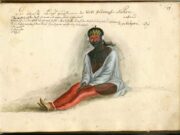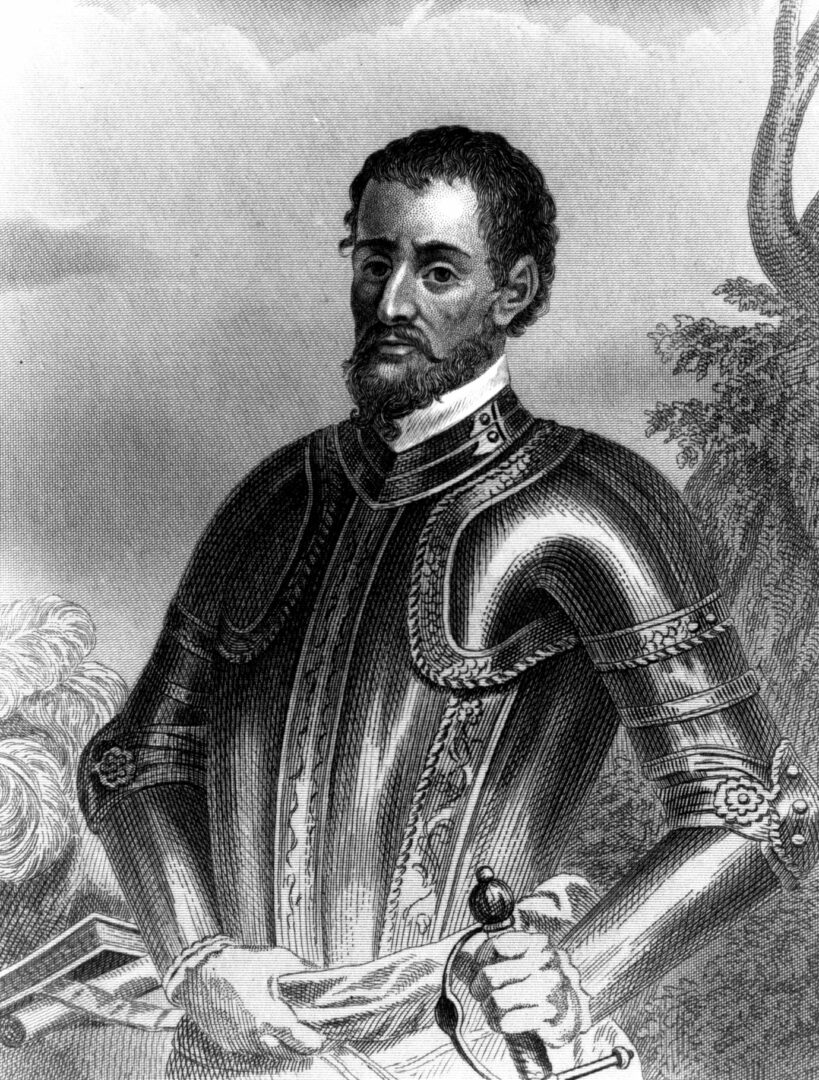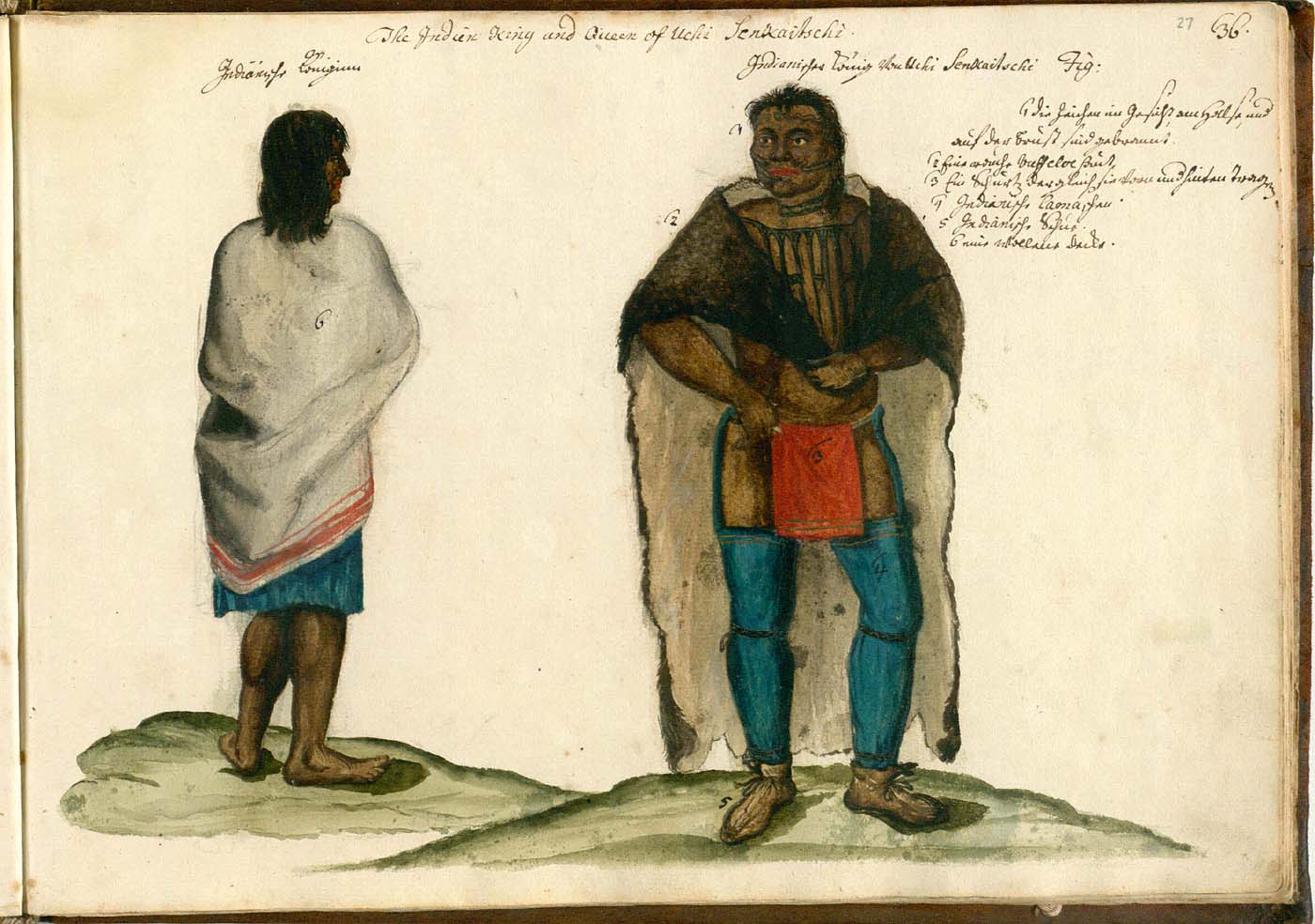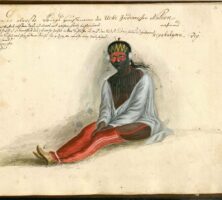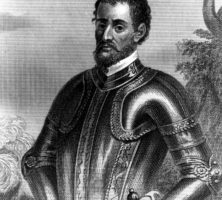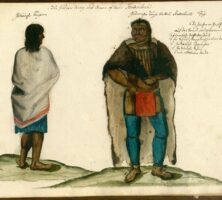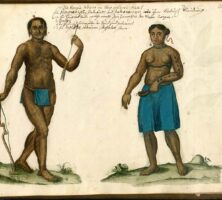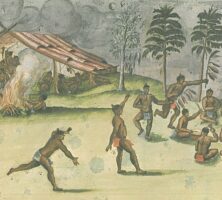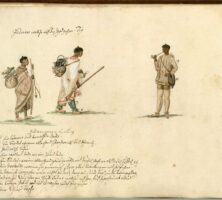When the English came to America, the Native Americans of Georgia encountered one of the most profound forces for change: the world economy.
European merchants ushered in this new economic system with a commercial trade in dressed animal skins but even more so with a commercial trade in enslaved Indians. The slave trade began in northeastern America and spread quickly. It had a profound effect on the Native Americans of Georgia from its beginning in the first half of the seventeenth century, through the full incorporation of Georgia Indians into the trade by the late seventeenth century, and until English trade interests turned to buying and selling the skins of white-tailed deer in the early eighteenth century.
Forces for Change
At the time of English settlement in present-day Geo rgia, the Native Americans of the South already were well into a profound process of transformation that had begun when they first encountered other Europeans. One of the first forces for change was epidemic disease. Within a few decades after the conquistador Hernando de Soto and his army of 600 made their way through the region in the mid-sixteenth century, the powerful chiefdoms of the Late Prehistoric Period began to collapse. Archaeologists believe that the demise of these societies was due, in part, to the devastating population loss from disease.
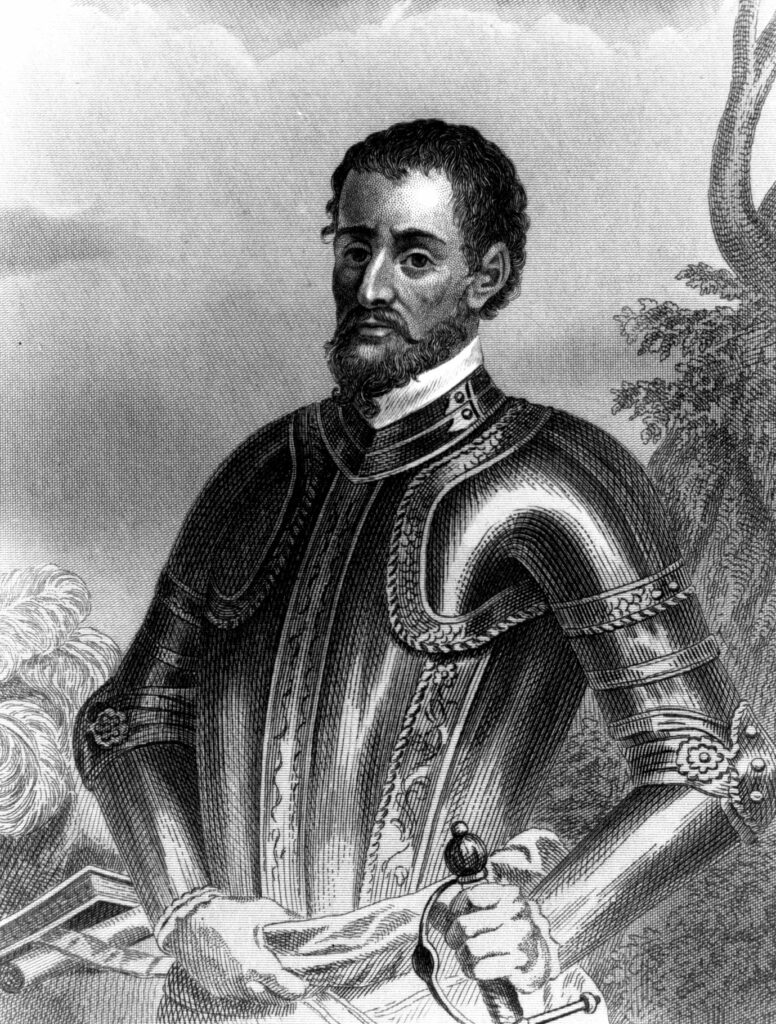
Courtesy of Georgia Info, Digital Library of Georgia.
In interior Georgia, Muskogee-speaking survivors of the collapse abandoned large areas and began joining together at certain areas of aggregation. One such area centered along the Piedmont stretch of the Oconee River and another along the Upper Coastal Plain section of the Chattahoochee River. Native Americans who lived in coastal Georgia and the barrier islands fell under another force for change: Spanish missionaries. After the establishment of St. Augustine, Florida, in 1565, Spanish Catholic missionaries labored among the Guale and Mocama of the Georgia coast and the Apalachee and Timucua of present-day north Florida.
How the Indian Slave Trade Worked
Native Americans were transformed by the new trading system. It was a commercial trade in dressed animal skins—and enslaved Indians. Slavery was not unknown to the indigenous peoples of the eastern woodlands, and they practiced a version of it at the time of contact with English traders. Once enslaved people became something to be bought and sold, however, a powerful new dynamic began shaping the lives of the Georgia Indians.
English traders would give European-made guns and ammunition to a group of Indians and demand that the guns be paid for with enslaved Native Americans. The armed groups would then raid an unarmed rival group to pay their debt. The unarmed group, now vulnerable to Indian slave raiders, would thus need guns and ammunition for protection and would have to acquire them. The Native Americans depended on the European trade for flintlock guns as well as for shot and powder. Therefore, anyone needing guns had to become a slave raider. In this way a cycle of dependency emerged.
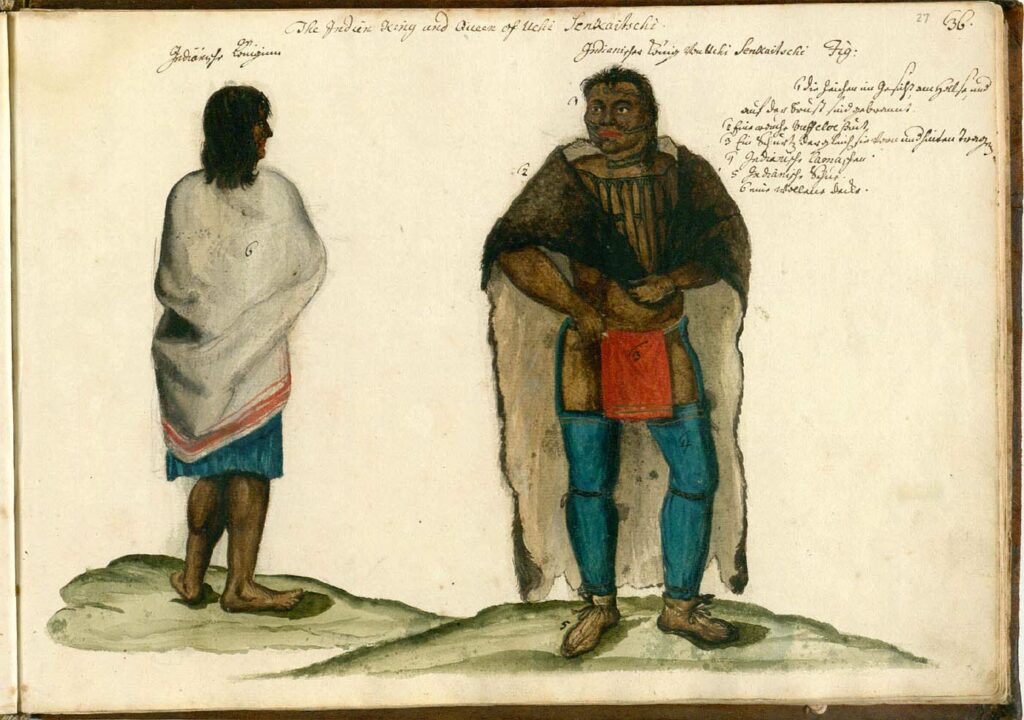
Illustration by Philip Georg Friedrich von Reck
Indian slave raiders took captives, mostly women and children, by the thousands and sold them to English, French, and Dutch slavers, who shipped them to the sugar plantations in the Caribbean, although some certainly went to the new coastal plantations in Virginia, South Carolina, and French Louisiana. For most native groups, already seriously weakened by losses from disease, slaving was a serious blow. Wherever slaving penetrated, the same processes unfolded: many Indian groups moved to escape slave raiders; some groups joined others in an effort to bolster their numbers and present a stronger defense; some groups became extinct after losses to disease and slave raiding; and all those left became part of the slave trade.
Slaving in Georgia
The trade in enslaved Native Americans first began in the Northeast. The Iroquois, seeking access to European goods and war captives whom they adopted into their kin groups to replace their dead, began doing business with English, French, and Dutch traders in the first few decades of the seventeenth century. Almost immediately this trade created a shatter zone of regional instability from which shock waves radiated out for hundreds of miles. The Indians of Georgia certainly felt these shock waves since some Iroquois raiders probably raided into north Georgia and since many of the northern groups suffering under Iroquois raids began to break up and move long distances west and south, seeking refuge.
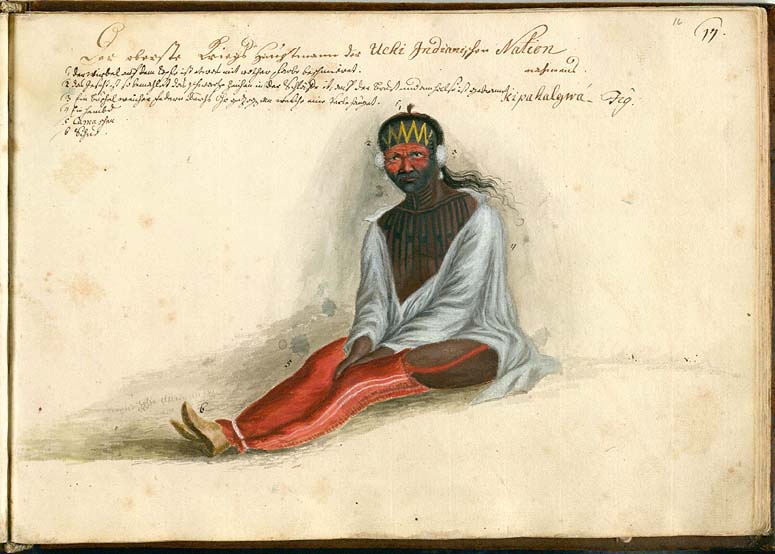
Illustration by Philip Georg Friedrich von Reck
Slaving in the South, however, probably did not become fully established until some time in the late seventeenth century, when Jamestown traders, recognizing the need for laboroers to work the tobacco plantations, engaged Piedmont groups like the Occaneechis and the Tuscaroras as slave raiders. Like the Iroquois, these Piedmont slavers first raided among their enemies close at hand. During this time Cherokee-speaking people living in the southern Appalachians may have moved southwest, away from the slave raiders, with some perhaps moving into areas of north Georgia that had been vacated during the collapse of the chiefdoms.
In the late 1650s another group of Indians fleeing Iroquois slave raiding, possibly the Erie, settled on the Savannah River. Here they became known as the Westos to the English and as Chichimecos to the Spanish. The Westos were predatory slave raiders, allied with English slavers in Virginia and heavily armed.
By 1679, in their strategy of playing the English and French off each other and in an effort to replace the hundreds who had died in an epidemic, Iroquois slave raiders struck out to the west and south. Thus began the Iroquois southern campaigns against the “flatheads,” a term the Iroquois applied to all of the southern groups because of their custom of flattening the backs of their infants’ skulls at birth. In the South the Iroquois ranged far and wide. The extant records document their presence in the Carolina Piedmont, in Georgia and Alabama, in northern Florida, in Mississippi, Louisiana, Arkansas, Tennessee, and Kentucky. The Iroquois campaign lasted almost forty years; the Westos’ reign of terror lasted almost twenty years.
Assailed from the north by the Iroquois and from the east by the Westos, Indians deep in the interior of Georgia sought refuge by moving southward and westward. The groups that had settled along the upper Oconee dispersed, with some moving to the Chattahoochee River and with some perhaps joining the Timucuas and Apalachees. Others moved closer to the Spanish mission Indians of Guale and Mocama, on the Georgia coast, and became known as the Yamasees. The Cherokees, somewhat protected by their mountain location, began to coalesce as an identifiable political entity. Cherokee towns took in many refugee groups and organized themselves into the divisions known during the Historic Period—the Overhill Towns, the Middle Towns, the Out Towns, the Valley Towns, and the Lower Towns. The latter two divisions made up the Cherokee inhabitants of north Georgia.
Westos slaving ended in 1681. When it became obvious that they were not under English control, the Carolinians hired a group of Shawnees, who had moved to the Savannah River in 1674 (possibly as one of many groups leaving the Ohio Valley because of Iroquois raiding), to destroy the Westos. A few years later, English pirates forced the Guales, Mocamas, and Yamasees to flee south to Amelia Island. In another testament to the unsettled alliances of the time, in 1685 the Yamasees, now allied with the English, began raiding the mission Indians, decimating the Timucua of northeast Florida by 1704.
By this time Carolina and Virginia traders also began to make contact with many of the natives in the interior of Georgia, approaching both the Cherokees and those groups who now lived along the Chattahoochee River. Both became slavers, and the latter group even moved to the Ocmulgee River, near present-day Macon, to be closer to the English traders. Here they continued to take in refugees and became known as the Ochese Creek, forming the nucleus of the people who would become known as the Lower Creeks. Lower Creek slavers, along with Yamasee and Shawnee slavers, continued to target the mission Indians of Florida, probably under English persuasion but certainly to their own benefit. Through a series of devastating slave raids, the few remaining Timucuans were forced into southern Florida and later fled to Cuba. The last remaining province of mission Indians, the Apalachee, was gone by 1704, when the handful of refugees who remained fled west, to present-day Louisiana.
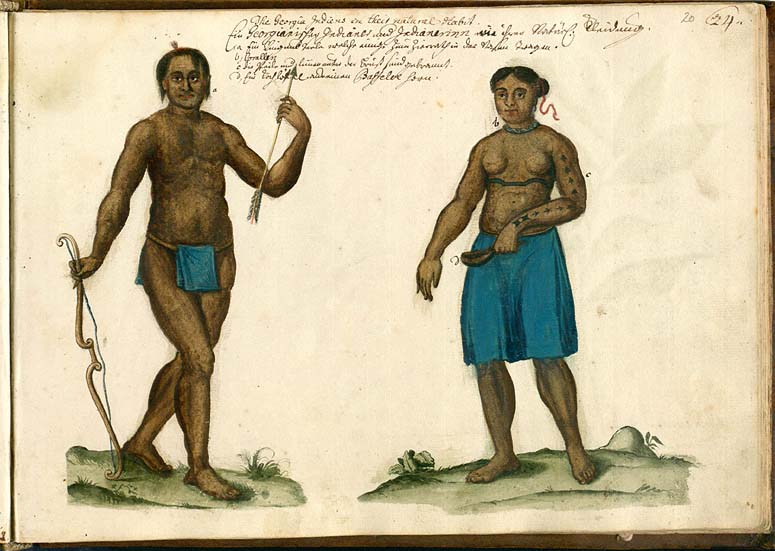
Illustrations by Philip Georg Friedrich von Reck
Formation of the Coalescent Societies
Meanwhile, the same forces swept into the west and north of present-day Georgia, as native slavers, trading with the English, French, and Dutch, raided far and wide throughout the eastern woodlands. The same process of dislocation and migration took place, and many groups banded together. These new groups became known as the Catawbas, the Chickasaws, the Choctaws, and the Upper Creeks, who later joined the Lower Creeks to form the Creek Confederacy. We still lack an adequate vocabulary to describe the Indian societies of the seventeenth and eighteenth centuries. They have been called “confederacies,” “tribes,” and “nations.” For convenience some scholars call them “coalescent” societies, because they were all, in varying degrees, coalescences of people from different societies, cultures, and languages.
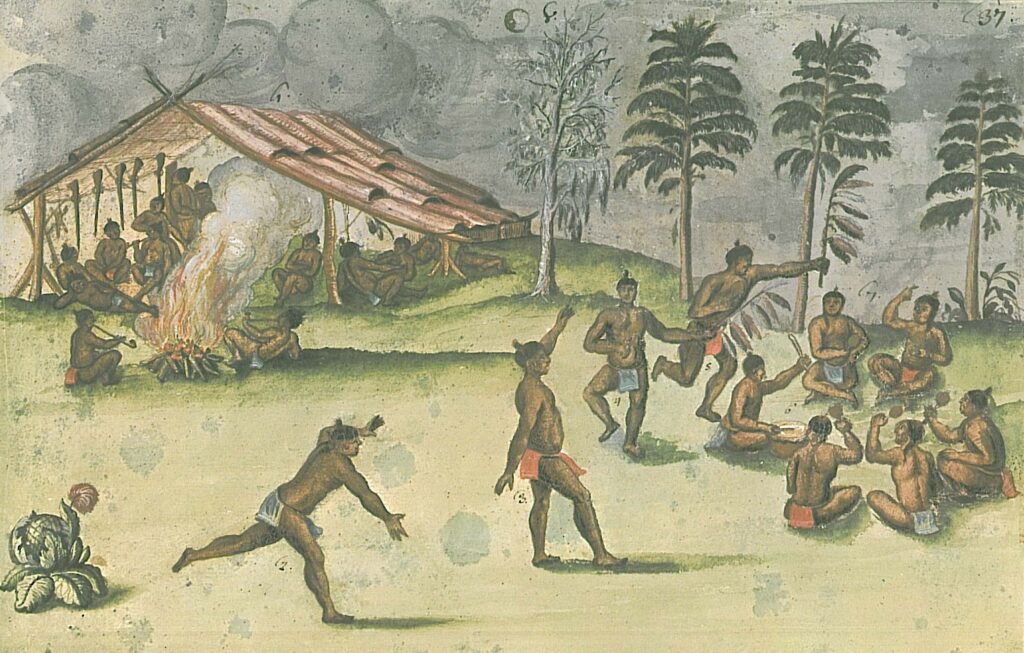
Illustration by Philip Georg Friedrich von Reck
As the coalescent societies began to form, Native Americans in Georgia and throughout the South revolted against the slave trade and the English, in particular. This revolt, known as the Yamasee War of 1715, served the Indians’ purpose of reforming the trade, if not annihilating the English. Although enslaved Indians continued to be bought and sold, the Yamasee War redirected English economic interests from enslaved Native Americans to the skins of white-tailed deer. The Native Americans had made it clear to the English that slaving on such a large scale was dangerous, and the English concluded that importing enslaved Africans was safer and more profitable. The Indians of Georgia, now fully incorporated into the new economic system, turned to the deerskin trade as willing and savvy participants.
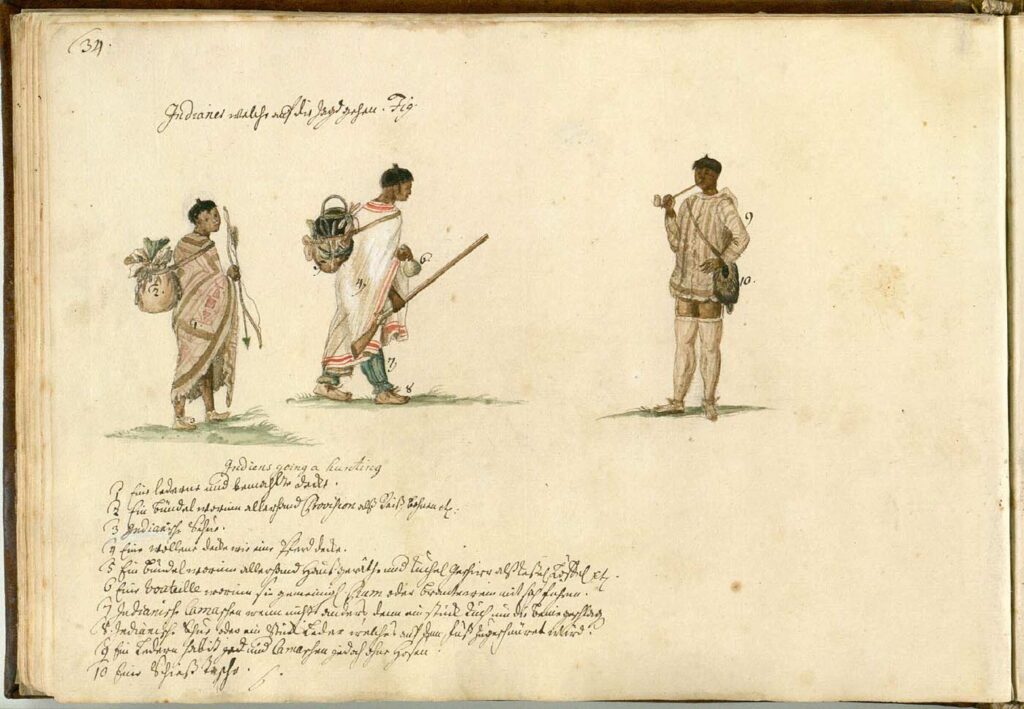
Illustration by Philip Georg Friedrich von Reck
When General James Edward Oglethorpe settled Savannah in 1733, the natives he encountered were quite different from the native peoples that Hernando de Soto had encountered 200 years earlier; they were different even from the native peoples that the Virginia traders had encountered 100 years earlier. For Oglethorpe encountered the great coalescent societies of the Late Historic Period, the Cherokees and the Creeks—societies quite experienced in dealing with Europeans. Their societies had been shaped by their experiences with Europeans and in response to the new world economy in which they now were enmeshed.


